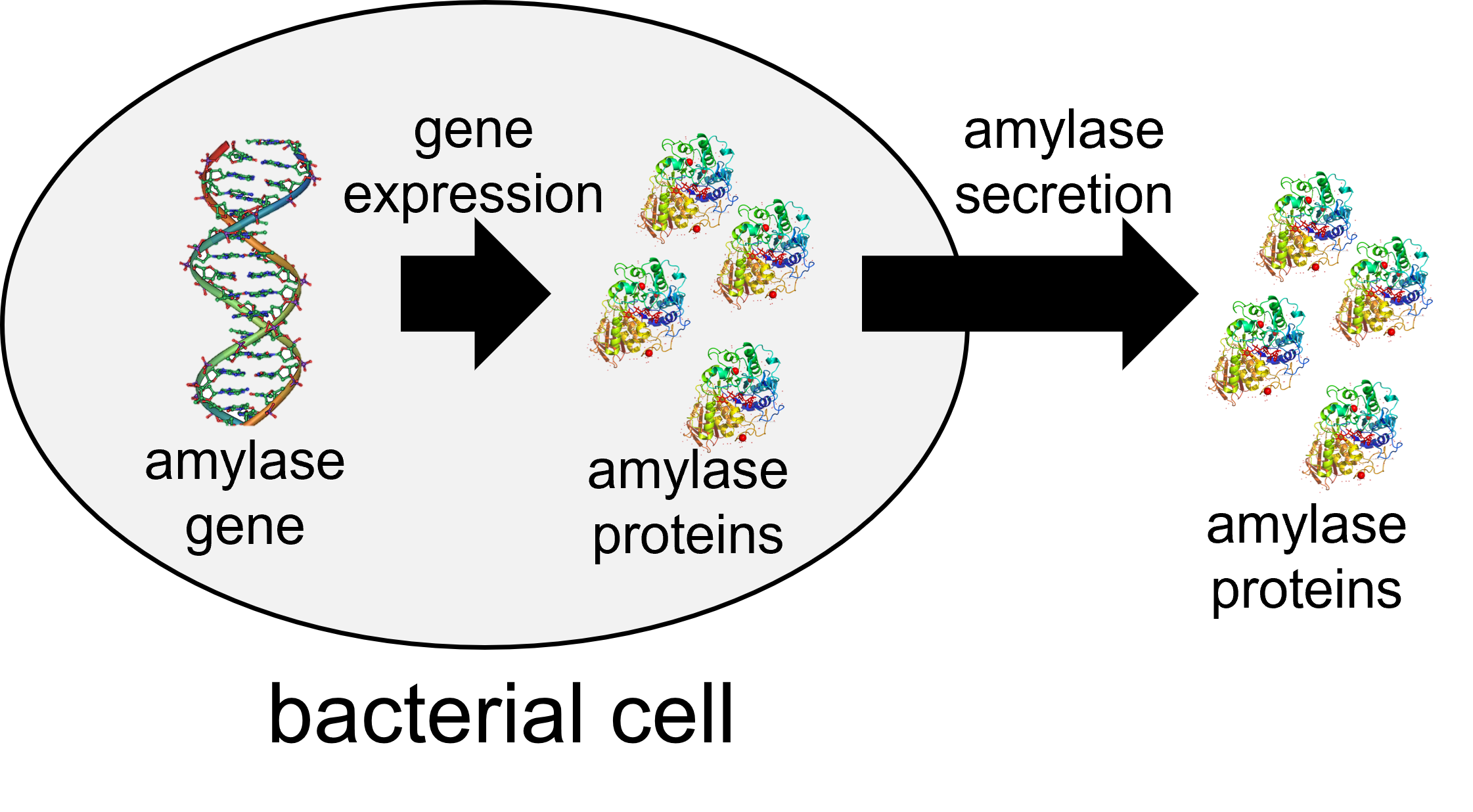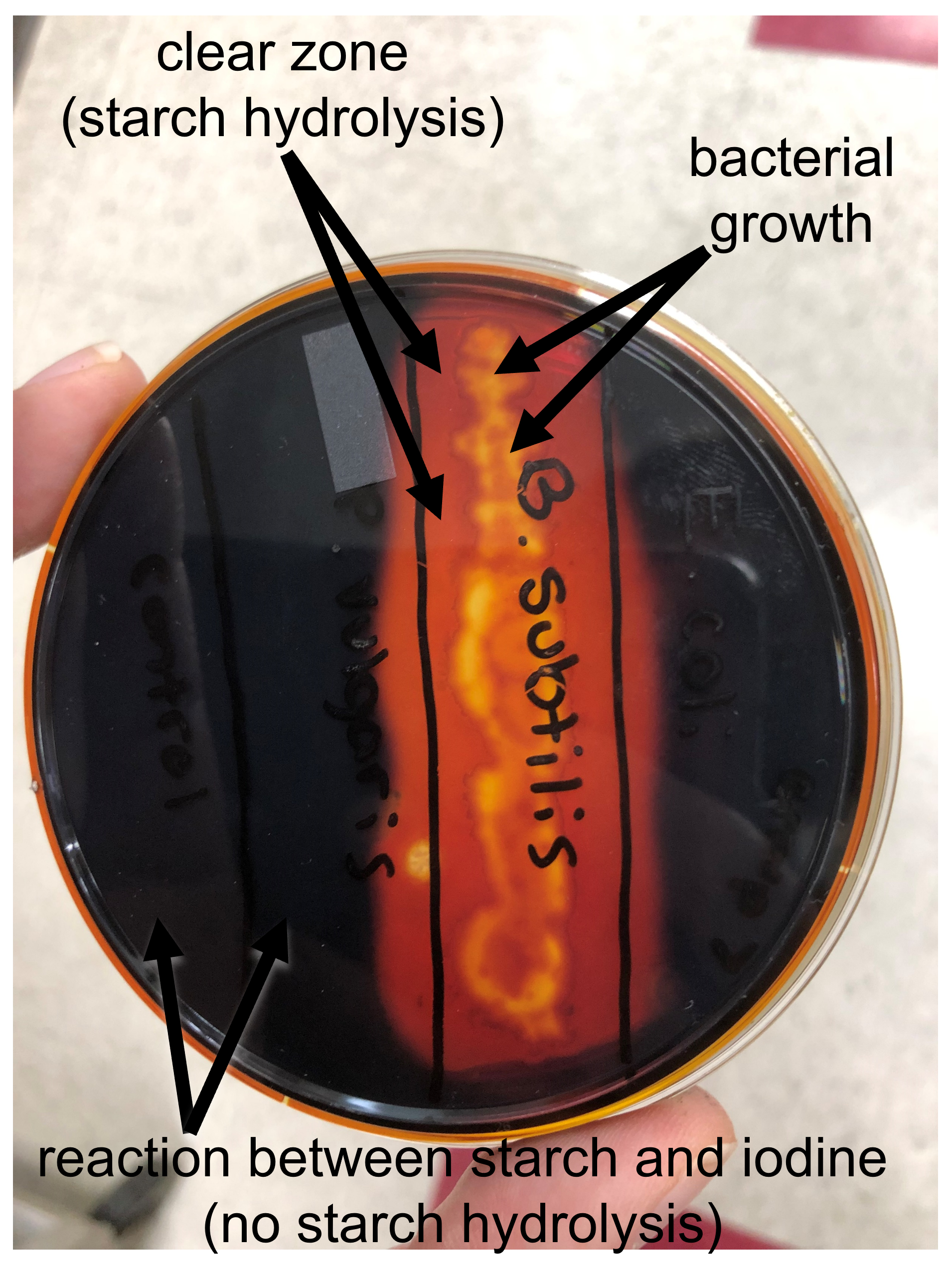4.3: Starch Hydrolysis
- Page ID
- 149785
\( \newcommand{\vecs}[1]{\overset { \scriptstyle \rightharpoonup} {\mathbf{#1}} } \)
\( \newcommand{\vecd}[1]{\overset{-\!-\!\rightharpoonup}{\vphantom{a}\smash {#1}}} \)
\( \newcommand{\dsum}{\displaystyle\sum\limits} \)
\( \newcommand{\dint}{\displaystyle\int\limits} \)
\( \newcommand{\dlim}{\displaystyle\lim\limits} \)
\( \newcommand{\id}{\mathrm{id}}\) \( \newcommand{\Span}{\mathrm{span}}\)
( \newcommand{\kernel}{\mathrm{null}\,}\) \( \newcommand{\range}{\mathrm{range}\,}\)
\( \newcommand{\RealPart}{\mathrm{Re}}\) \( \newcommand{\ImaginaryPart}{\mathrm{Im}}\)
\( \newcommand{\Argument}{\mathrm{Arg}}\) \( \newcommand{\norm}[1]{\| #1 \|}\)
\( \newcommand{\inner}[2]{\langle #1, #2 \rangle}\)
\( \newcommand{\Span}{\mathrm{span}}\)
\( \newcommand{\id}{\mathrm{id}}\)
\( \newcommand{\Span}{\mathrm{span}}\)
\( \newcommand{\kernel}{\mathrm{null}\,}\)
\( \newcommand{\range}{\mathrm{range}\,}\)
\( \newcommand{\RealPart}{\mathrm{Re}}\)
\( \newcommand{\ImaginaryPart}{\mathrm{Im}}\)
\( \newcommand{\Argument}{\mathrm{Arg}}\)
\( \newcommand{\norm}[1]{\| #1 \|}\)
\( \newcommand{\inner}[2]{\langle #1, #2 \rangle}\)
\( \newcommand{\Span}{\mathrm{span}}\) \( \newcommand{\AA}{\unicode[.8,0]{x212B}}\)
\( \newcommand{\vectorA}[1]{\vec{#1}} % arrow\)
\( \newcommand{\vectorAt}[1]{\vec{\text{#1}}} % arrow\)
\( \newcommand{\vectorB}[1]{\overset { \scriptstyle \rightharpoonup} {\mathbf{#1}} } \)
\( \newcommand{\vectorC}[1]{\textbf{#1}} \)
\( \newcommand{\vectorD}[1]{\overrightarrow{#1}} \)
\( \newcommand{\vectorDt}[1]{\overrightarrow{\text{#1}}} \)
\( \newcommand{\vectE}[1]{\overset{-\!-\!\rightharpoonup}{\vphantom{a}\smash{\mathbf {#1}}}} \)
\( \newcommand{\vecs}[1]{\overset { \scriptstyle \rightharpoonup} {\mathbf{#1}} } \)
\( \newcommand{\vecd}[1]{\overset{-\!-\!\rightharpoonup}{\vphantom{a}\smash {#1}}} \)
\(\newcommand{\avec}{\mathbf a}\) \(\newcommand{\bvec}{\mathbf b}\) \(\newcommand{\cvec}{\mathbf c}\) \(\newcommand{\dvec}{\mathbf d}\) \(\newcommand{\dtil}{\widetilde{\mathbf d}}\) \(\newcommand{\evec}{\mathbf e}\) \(\newcommand{\fvec}{\mathbf f}\) \(\newcommand{\nvec}{\mathbf n}\) \(\newcommand{\pvec}{\mathbf p}\) \(\newcommand{\qvec}{\mathbf q}\) \(\newcommand{\svec}{\mathbf s}\) \(\newcommand{\tvec}{\mathbf t}\) \(\newcommand{\uvec}{\mathbf u}\) \(\newcommand{\vvec}{\mathbf v}\) \(\newcommand{\wvec}{\mathbf w}\) \(\newcommand{\xvec}{\mathbf x}\) \(\newcommand{\yvec}{\mathbf y}\) \(\newcommand{\zvec}{\mathbf z}\) \(\newcommand{\rvec}{\mathbf r}\) \(\newcommand{\mvec}{\mathbf m}\) \(\newcommand{\zerovec}{\mathbf 0}\) \(\newcommand{\onevec}{\mathbf 1}\) \(\newcommand{\real}{\mathbb R}\) \(\newcommand{\twovec}[2]{\left[\begin{array}{r}#1 \\ #2 \end{array}\right]}\) \(\newcommand{\ctwovec}[2]{\left[\begin{array}{c}#1 \\ #2 \end{array}\right]}\) \(\newcommand{\threevec}[3]{\left[\begin{array}{r}#1 \\ #2 \\ #3 \end{array}\right]}\) \(\newcommand{\cthreevec}[3]{\left[\begin{array}{c}#1 \\ #2 \\ #3 \end{array}\right]}\) \(\newcommand{\fourvec}[4]{\left[\begin{array}{r}#1 \\ #2 \\ #3 \\ #4 \end{array}\right]}\) \(\newcommand{\cfourvec}[4]{\left[\begin{array}{c}#1 \\ #2 \\ #3 \\ #4 \end{array}\right]}\) \(\newcommand{\fivevec}[5]{\left[\begin{array}{r}#1 \\ #2 \\ #3 \\ #4 \\ #5 \\ \end{array}\right]}\) \(\newcommand{\cfivevec}[5]{\left[\begin{array}{c}#1 \\ #2 \\ #3 \\ #4 \\ #5 \\ \end{array}\right]}\) \(\newcommand{\mattwo}[4]{\left[\begin{array}{rr}#1 \amp #2 \\ #3 \amp #4 \\ \end{array}\right]}\) \(\newcommand{\laspan}[1]{\text{Span}\{#1\}}\) \(\newcommand{\bcal}{\cal B}\) \(\newcommand{\ccal}{\cal C}\) \(\newcommand{\scal}{\cal S}\) \(\newcommand{\wcal}{\cal W}\) \(\newcommand{\ecal}{\cal E}\) \(\newcommand{\coords}[2]{\left\{#1\right\}_{#2}}\) \(\newcommand{\gray}[1]{\color{gray}{#1}}\) \(\newcommand{\lgray}[1]{\color{lightgray}{#1}}\) \(\newcommand{\rank}{\operatorname{rank}}\) \(\newcommand{\row}{\text{Row}}\) \(\newcommand{\col}{\text{Col}}\) \(\renewcommand{\row}{\text{Row}}\) \(\newcommand{\nul}{\text{Nul}}\) \(\newcommand{\var}{\text{Var}}\) \(\newcommand{\corr}{\text{corr}}\) \(\newcommand{\len}[1]{\left|#1\right|}\) \(\newcommand{\bbar}{\overline{\bvec}}\) \(\newcommand{\bhat}{\widehat{\bvec}}\) \(\newcommand{\bperp}{\bvec^\perp}\) \(\newcommand{\xhat}{\widehat{\xvec}}\) \(\newcommand{\vhat}{\widehat{\vvec}}\) \(\newcommand{\uhat}{\widehat{\uvec}}\) \(\newcommand{\what}{\widehat{\wvec}}\) \(\newcommand{\Sighat}{\widehat{\Sigma}}\) \(\newcommand{\lt}{<}\) \(\newcommand{\gt}{>}\) \(\newcommand{\amp}{&}\) \(\definecolor{fillinmathshade}{gray}{0.9}\)- Explain what the starch hydrolysis test is and how it works.
- Explain how starch hydrolysis relates to the amylase gene and the enzyme amylase.
- State the chemical reaction that occurs when bacteria hydrolyze starch.
- Successfully conduct the starch hydrolysis test.
- Interpret the results of the starch hydrolysis test.
- State why starch hydrolysis is a beneficial characteristic for bacteria.
- Tell that starch hydrolysis is a characteristic that only some bacterial species have and that is therefore useful for species identification and characterization.
Starch Hydrolysis Test
Starch is a long carbohydrate molecule made of hundreds of glucose molecules bonded together into a very long chain. There is a lot of energy in starch! If bacteria are able to break down starch, this is an advantage because that means they can access the sugars in starch and the energy in those sugars (as well as the carbon).

Some species of bacteria can break down starch and some species of bacteria cannot break down starch. Whether a bacterial species can break down starch or not is based on whether they have a gene (a segment of DNA) that codes for the enzyme amylase. Amylase is an enzyme that breaks down starch into smaller sugars.
Starch is too large to pass through the plasma membrane of a cell and must be split into individual glucose molecules. Bacteria that can produce the exoenzyme amylase are able to hydrolyze starch by secreting these enzymes into the environment around them. The enzyme amylase is secreted out of the cells (amylase is considered an exoenzyme, meaning it is an enzyme secreted outside of the cells ["exo-" means "outside"]) into the surrounding media, catalyzing the breakdown of starch into smaller sugars. These smaller sugars can then be absorbed by the cells and the cells can use the sugars as a source of energy and carbon.

Since only some species of bacteria are capable of breaking down starch (aka starch hydrolysis) testing if bacteria can break down starch or not is a way we can differentiate one bacterial species from another. Therefore, examining starch hydrolysis of a bacterial species is useful for identifying and characterizing bacterial species. Starch can be added to petri plate media in order to determine if bacteria are capable of breaking down the starch.
Starch inside of a petri plate is clear and cannot be seen without using iodine. Iodine reacts with starch, producing a black or bluish-black color. As starch is hydrolyzed by bacterial amylase and is converted to sugars, there will be less and less starch to react with the iodine. Strong amylase producers may convert all of the starch in the agar to sugars, while weak amylase producers may convert the starch surrounding the growth areas only.
After bacteria are allowed to grow, iodine is added to the petri plate to detect the presence and absence of starch.
- Where starch is on the petri plate will appear blue-black. Iodine reacts with starch to produce blue-black coloration when starch is present.
- Where starch isn't on the petri plate will appear clear or yellowish. Iodine will not produce a blue-black color where starch is absent. These regions therefore appear a clear or yellowish color on the petri plate when starch is not present.
Since the entire petri plate contained starch at the start of the test, clear halos surrounding bacterial growth indicates that the bacterial species was able to hydrolyze the starch resulting in the clear zone without starch (we would say that this bacterial species is starch hydrolysis positive). If the growth does not exhibit clear zones surrounding it, the starch is intact throughout the plate (no starch hydrolysis or we say that the bacterial species is starch hydrolysis negative).

Laboratory Instructions
Inoculating Starch Plates
- Obtain a starch agar petri plate.
- Write on the bottom of the starch agar petri plate to separate the plate into four sections. Label as shown above.
- Aseptically make a single line streak of the corresponding bacterial species in each of the sections on the petri plate. The "control" region will remain empty (no bacterial streak).
- Invert the petri plate and incubate at either 25º C or 37º C for 24-28 hours.
Adding Iodine to Visualize Location of Starch

- After the starch plate has incubated and bacteria is growing on the surface, placing the agar plate on a white piece of paper or white background since this will really help you to distinguish whether or not clear zones occurred.
- Cover the agar and growth with iodine.
- Examine the petri plate. Species that hydrolyze starch will have a region around the bacterial growth that is yellowish or clear around the growth (the growth may appear light in color - look for a clear zone surrounding the growth [the growth is raised on the plate]). When starch is not hydrolyzed, the growth may appear lighter in color, but there is no clear zone surrounding the growth (unless the clear zone is extending from a bacterial species that does hydrolyze starch.
Results & Questions
| Bacterial Species | Result for Starch Hydrolysis (+ or -) | Does this species produce amylase? | Does this species have the amylase gene? |
|---|---|---|---|
| Escherichia coli | |||
| Bacillus subtilis | |||
| Proteus vulgaris |
- Complete the table above to indicate the results of this experiment.
- What does it mean, in the starch hydrolysis test, when there is a clear zone surrounding bacterial growth?
- What does it mean, in the starch hydrolysis test, when there is no clear zone surrounding bacterial growth?
- What is hydrolysis?
- What is starch hydrolysis?
- What is amylase?
- Give the chemical reaction catalyzed by amylase.
- Why is it an advantage for a bacterial species to be able to hydrolyze starch?
- Do all bacteria hydrolyze starch? Explain your answer.
- Fill in the blank. Whether a species of bacteria is capable of producing amylase is dependent on _________.
- The starch hydrolysis test is useful for identifying and characterizing bacteria. Why?
Attributions
- 3-D Structure of Alpha-amylase.png by MikeyB88 is licensed under CC BY-SA 4.0
- Chapter Image: Starch hydrolysis.png by Eunice Laurent is licensed under CC BY-SA 4.0
- DNA double helix horizontal.png by Jerome Walker is in the public domain
- General Microbiology Lab Manual (Pakpour & Horgan) by Nazzy Pakpour & Sharon Horgan is licensed under CC BY-SA 4.0
- Laboratory Exercises in Microbiology: Discovering the Unseen World Through Hands-On Investigation by Susan McLaughlin and Joan Petersen is licensed under CC BY-NC-SA
- Microbiology Labs I by Delmar Larsen and Jackie Reynolds is licensed under an undeclared license


